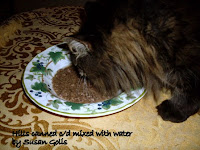With so many flea treatments available it is difficult to know which flea remedy is right for your cat. Many of the topical applications of flea treatments are not as toxic as one would think, however, if your cat has feline Leukemia or immunodeficiency virus you may be concerned with the toxicity of the topical or internal flea treatments and how they affect your cat long term. For this health concern, many people are turning to Diatomaceous Earth Flea Treatment for Cats.
Treat your Home with Diatomaceous Earth Food Grade
 |
| Adult cat flea: Wikipedia Commons |
My cat Sam has Feline immunodeficiency virus and due to his health condition, I was concerned about using chemical-based flea treatments.
I asked a friend who has experience with cats with Feline Immunodeficiency what she used and she told me about Diatomaceous Earth and food grade. I purchased the safe and natural product at amazon.com and used it to treat my home and my cat for fleas.
I asked a friend who has experience with cats with Feline Immunodeficiency what she used and she told me about Diatomaceous Earth and food grade. I purchased the safe and natural product at amazon.com and used it to treat my home and my cat for fleas.
Treat your Home with Diatomaceous Earth Food Grade
The best way to prevent your cat from becoming infested with fleas is to treat your home with a safe and natural flea preventative. Kill household pests with diatomaceous earth food grade.
Follow the direction on the package. I always vacuum my carpets and my upholstered furniture before filling a duster or shaker with DE. Treat your entire house; carpets, upholstered furniture, drapes, bedding, pet beds, cat trees, and scratching posts. Treat all areas where fleas or ticks would hide.
Know that you will have to treat your home monthly if you have pets that go outdoors. If you work in the garden or do yard work fleas can hitch a ride on your clothing.
Diatomaceous Earth food grade for Cats
If your cat has fleas crawling on them then sprinkle a small amount of the earth onto the palm side of your hands. Then rub the earth onto your cat’s fur. For me, I find this is the best way to apply the powder to my cat's fur.
If your cats do not have fleas then do not do this. Know that If your home is treated with DE then it dehydrates the flea quickly and they will die. Your cat will benefit from the whole house treatment by lying on the carpet or on their pet beds.
Groom your cats with a flea comb to remove dead fleas.
Diatomaceous earth food grade is safe and natural for humans and pets.
If your cats do not have fleas then do not do this. Know that If your home is treated with DE then it dehydrates the flea quickly and they will die. Your cat will benefit from the whole house treatment by lying on the carpet or on their pet beds.
Groom your cats with a flea comb to remove dead fleas.
Diatomaceous earth food grade is safe and natural for humans and pets.
Very important to buy only food grade product. Read the label to make sure if is safe for humans and pets.









